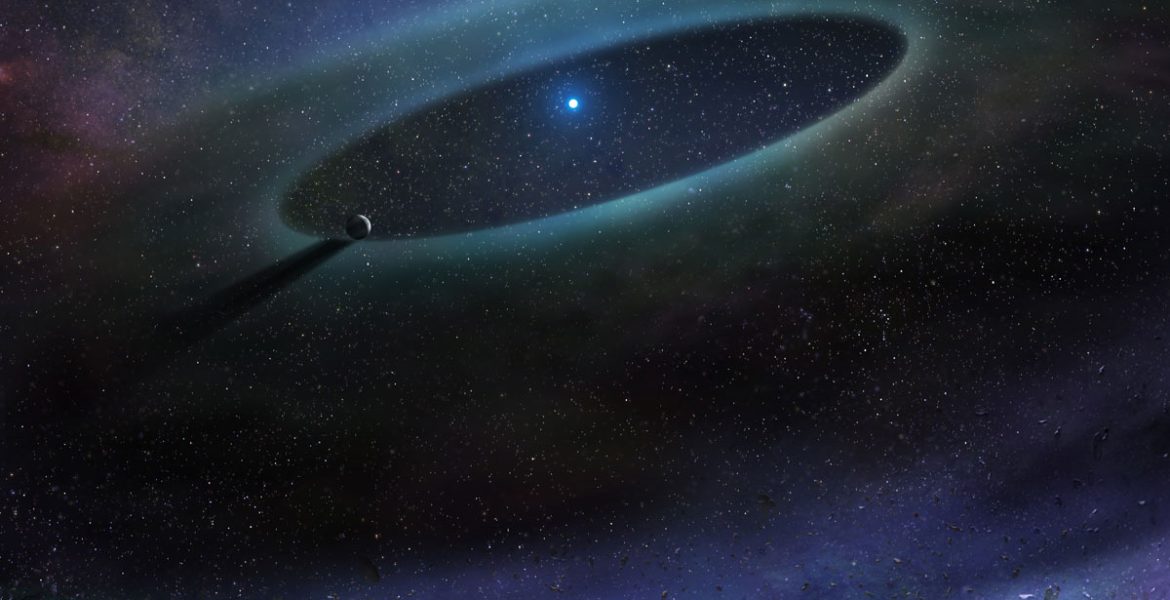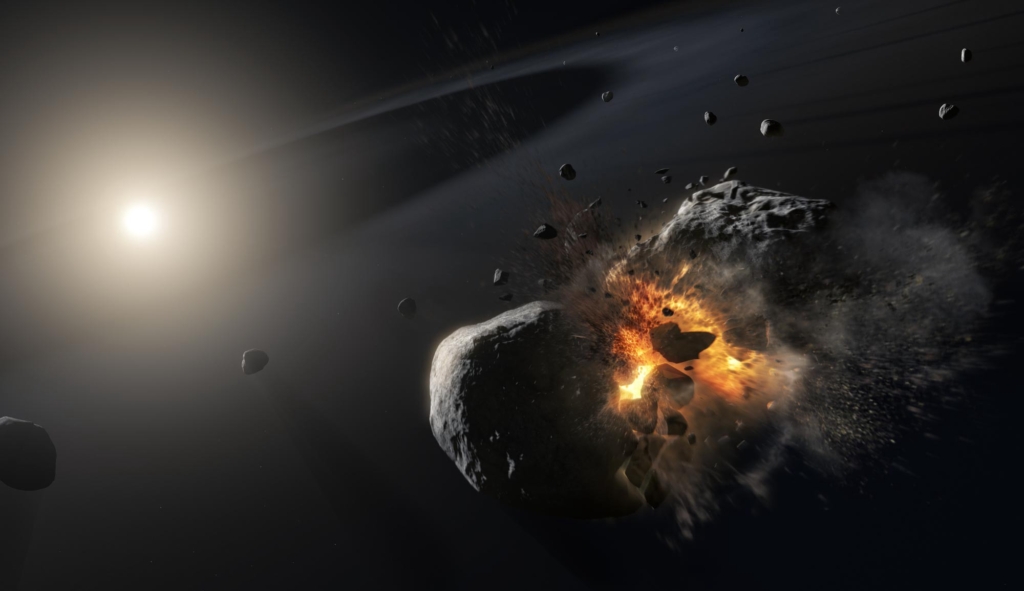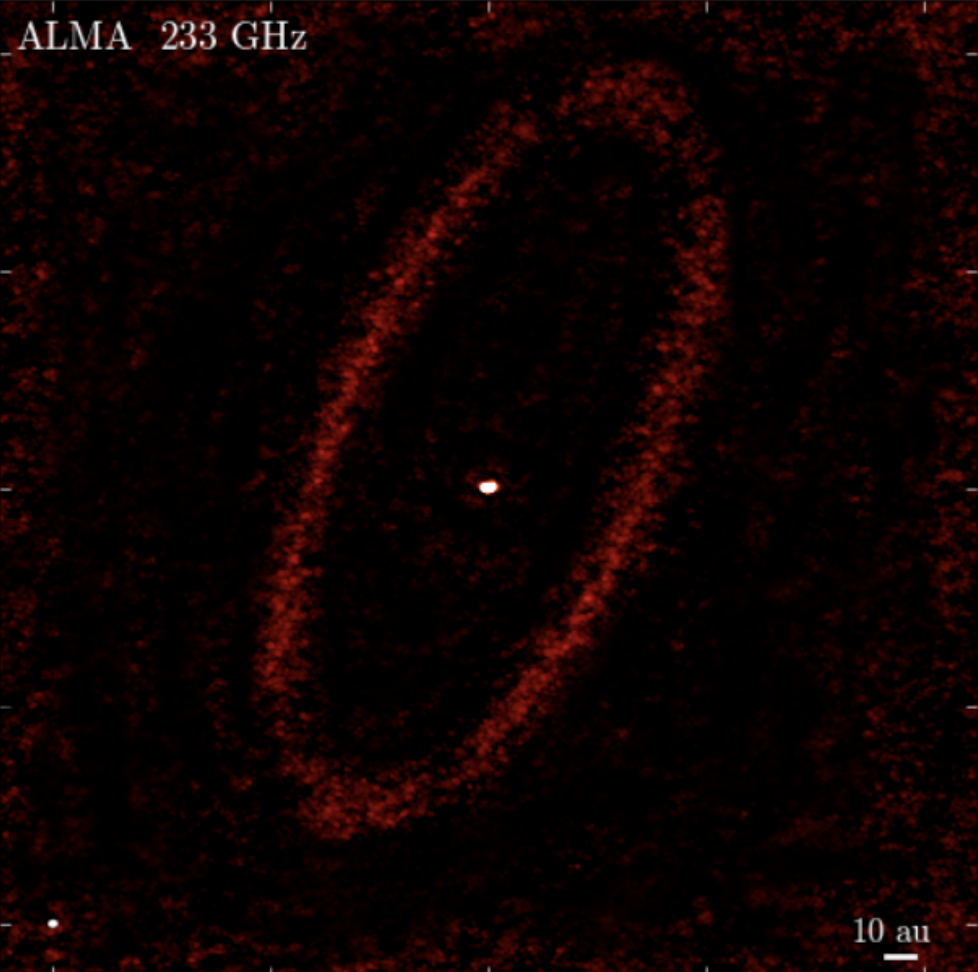This article was originally published in Medium on March 9, 2021. Some changes have been made to the original text with permission from the author.
Debris disks may sound like a completely foreign concept. But you’re probably familiar with some that go by different names! Have you heard of the asteroid belt, Kuiper belt, or Oort cloud in our Solar System? All of these things can be thought of as debris disks.
These debris disks can essentially be thought of as “leftovers” from when the Solar System formed. The asteroid belt, as the name implies, is mostly asteroids. It exists in a ring of material between the orbits of Mars and Jupiter. The Kuiper belt is mostly comets, is a bit broader than the asteroid belt, and extends from approximately Pluto’s orbit into the outer parts of the Solar system. The Oort cloud is in the very far reaches of the Solar System. It has a more spherical shape, as opposed to a ring, and is made up of millions of comets on very long orbits around the Sun (by long I mean something like hundreds of thousands to tens of millions of years!).
But we aren’t special (sorry). Debris disks are found around lots of stars other than our Sun: bigger stars and smaller stars; hotter stars and cooler stars; younger stars and older stars. In fact, it seems debris disks may be the most abundant around stars that are around twice the size of the Sun.
But, first, let’s rewind the clock a bit…
How Do Debris Disks Form?
To answer this question we need to ask another question: how do planets form? (And technically to answer that question we need to ask how the universe formed). Then we have to ask another question — how did the universe evolve up until the start of a given planetary system’s formation.
But that’s too many questions. For simplicity, we’ll just start with the assumption that the universe formed and evolved in such a way that we can get the correct “initial conditions” for planetary systems to form. This means we have the right abundance of heavy elements, molecules, gas, dust, etc. so that planet formation is at least possible.
In the beginning…
Clouds of gas and dust, with diameters spanning 10s of light-years or more, are scattered through our galaxy (and other galaxies, too). Due to either turbulence, or self-gravity between gas/dust particles, or a supernova jump-starting the process, these clouds start to clump together and collapse on themselves. After thousands to hundreds of thousands of years, at the center of these clumps, a protostar starts to form. The protostar becomes really hot, which in turn heats the material around it.
During the early stages of star formation, lots of extra gas and dust will be pulled into the area around a young protostar. Due to the conservation of angular momentum (remember those videos of a twirling ice skater pulling their arms in and speeding up), this extra material flattens out into a disk, known as a protoplanetary disk. Over the next few million years, through lots of different proposed mechanisms, larger and larger clumps of material can start to form within this disk. As these clumps get larger, their gravity allows them to pull in more material. This process can carve out gaps in a disk, and even eventually make planets! Like most things in nature, the planet formation process is not 100% efficient. There will be lots of leftovers, such as clumps of material that are not big enough to be planets. Most of them will be comets and asteroids, depending on how cold it is in the place they formed in the disk.

The transition from protoplanetary disk to debris disk occurs during the next million to few millions of years. Material clumps together, the star approaches “adulthood”, and the planets sweep up all the remaining gas and dust. Given time, and assuming there are enough clumps of material leftover, asteroids and comets will collide into each other throughout the disk. This process is called dynamical evolution. As you can imagine, a violent collision such as this will generate a bunch of smaller chunks of rock and ice and even small dust and pebble-sized material. This collisionally produced debris will replenish the small dust grains in the disk that were originally swept up by the planets.
While these pebble-sized grains are small, there are a LOT of them. Just imagine if two 50-km-diameter asteroids crashed into each other and were vaporized into millimeter-sized debris (hey, that’s where the debris part of debris disk comes from!). If the process was 100% efficient, there would be 5,000,000,000,000,000 millimeter-sized objects (or 5 quadrillion or 5 million billion) reintroduced to the disk. And only from one collision. These disks contain billions (yes with a “B”) of these objects, so it’s easy to see how this process can significantly repopulate the small solids within a debris disk.
Ok, so…
Why does all this all matter? We can’t see small millimeter-sized debris orbiting around a star that is 5, 10, 100 light-years away, right? Wrong! We actually CAN see this debris! And we can only see these small grains. We can’t actually see the asteroids or comets that they originally came from.
We have taken many images of debris disks. However, what we are seeing whenever we look at images of disks around Fomalhaut or Beta Pic is actually the small grains that orbit in the debris disks. The majority of the mass of the disks is indeed in the large comet- and asteroid-sized objects. However, the majority of the surface area (which is related to the light-emitting properties) is in the small grains.
There are a few different ways to observe these small grains in debris disks, such as with the Hubble Space Telescope or large ground-based telescopes, but one of the more exciting ways is using the Atacama Large Millimeter Array (ALMA). With its unprecedented resolution, ALMA can provide us with a detailed structure of the millimeter-sized grains (or pebbles) in a debris disk. These pebbles may not sound like much, but they actually emit a lot of radio wavelength light – even more than the big asteroids and comets! Even more impressive, by using ALMA we can even see some of the gas that is released by comets in debris disk collisions.
But why study debris disks? For one, when we see the remnants of planet formation, it tells us that the formation process was at least partially successful in that system. Sure, there are lots of known planetary systems, but most of these are much much older and a lot of the debris has cleared out. The first debris disks outside of our Solar System were actually detected before any exoplanets!

ESA/Hubble, M. Kornmesser.
A debris disk can be used as a “planet detector”. The disk’s location around a star can tell us about possible planets in the system. For example, Jupiter’s gravitational pull has effectively sculpted the asteroid belt in the inner Solar System. The inner edge of the Kuiper belt in the outer Solar system is dictated by Neptune. Alien astrophysicists could in theory look at our Solar system and infer the location of Jupiter and Neptune by looking at our debris.
There is a whole bunch of other really fascinating things that we can learn from debris. We can look at the spectra of a disk (how the light changes at different wavelengths) and learn a lot about its composition. Different minerals will form at various locations throughout a protoplanetary disk, depending on some factors like temperature and pressure. These minerals, of course, also get swept up into the larger asteroids and comets but are released back into the disk during collisions. Therefore the spectra of the debris can give us some clues as to the mineral composition of planets in that system. Studying debris disks also tells us a lot more about the system as a whole such as how grains migrate throughout a disk, the effects of dynamical stirring from planets, and even the abundance of different gases in comets!
In short, debris disks aren’t the rubbish the name implies. We study debris systems to better understand the final stages of planet formation and disk evolution. The planet formation process takes a while, typically millions of years. Therefore each individual system in the universe only represents a brief snapshot in the evolutionary process. That’s why we have to observe lots of different stars at different stages of disk evolution.
The ultimate goal is to better understand how unique our Solar System is and how common Earth-like planets may be. We can’t necessarily go to them. We can, however, observe different disks in the early stages of formation, the late stages of formation, and evolved exoplanetary systems. Each one is a different piece of the puzzle that when put together, gives us a picture of how the universe works and how we got here.








